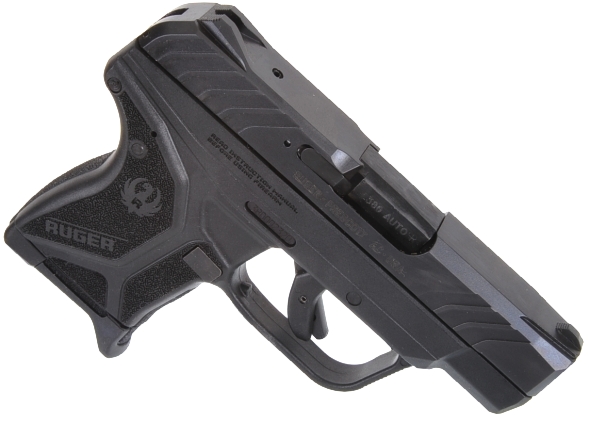
The more I poked at and shot the LCP II, the more I realized how little it has in common with the original LCP and how many refinements the little pistol has received both inside and out. As an example, the LCP II is a true single action autoloader; no preset strikers or hammers to coax to full travel with the trigger pull. Subsequently, the LCP II’s active pull is only 0.25″; no creep and a trigger stop eliminates overtravel. As a single action, a trigger safety has been added to prevent accidental discharge in the event the LCP II is dropped.
The LCP II is quite angular in form, but smooth in terms of being fed into or withdrawn from a holster. In the top down view below, the tapering angle cuts front and rear are more obvious.

The LCP II useful and no snag sights replace the sight nubs found on the original LCP, pictured below. The face of the rear sight is angled forward to kill glare for a clean aperture and the front side of the rear sight is open ahead of the aperture to collect light. The front sight ramp is serrated to kill glare.
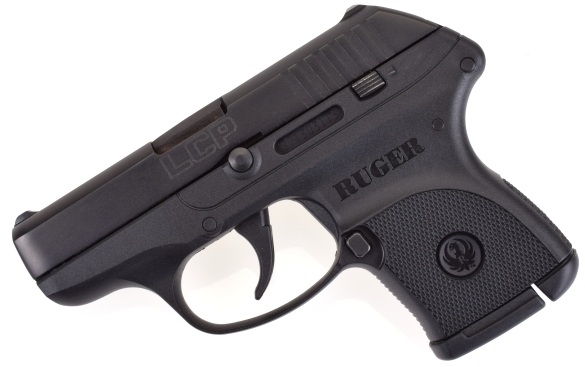
Below, the LCP II magazine release is located in the same place as the original LCP, however, magazines now eject clear when released and the LCP II locks open on empty. LCP magazines will function in the LCP II, however, without the lock open feature. The slide stop has been elongated in the LCP II for easier actuation. A front slide gripping surface has been added and both front and rear surfaces are made with a new pattern that makes it easy to grip even with sweaty or oily hands. Opening the slide requires less effort.
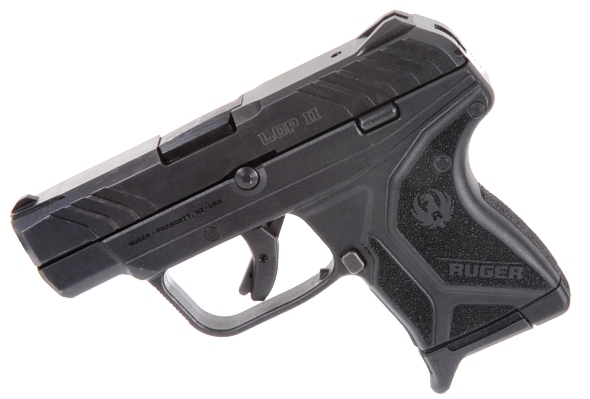
Like the original LCP, the new LCP II also has a polymer grip frame and an internal precision machined one piece aluminum chassis that mounts all of the fire control pieces. The LCP II trigger guard has been squared to form a two hand hold contact surface and all gripping surfaces have been checkered or stippled to make the LCP II a comfortable small pistol to hold and shoot.
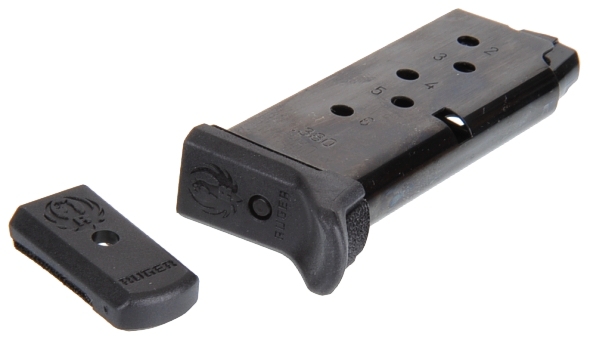
The LCP II is supplied with one six round magazine and both flush and extended bases. With extender in place, there is support for two fingers below the trigger guard which affords good control.
The LCP II, like the LCP, is an easy take down; pop out the magazine, pull the slide back and check for an empty chamber, release the slide and pop out the take down pin located in the frame above the trigger. There pin will not go willingly, but a small common screw driver under the pin’s head and a little leverage will get the job done. A sheet of paper slipped between the slide and screw driver will prevent slide scratching.
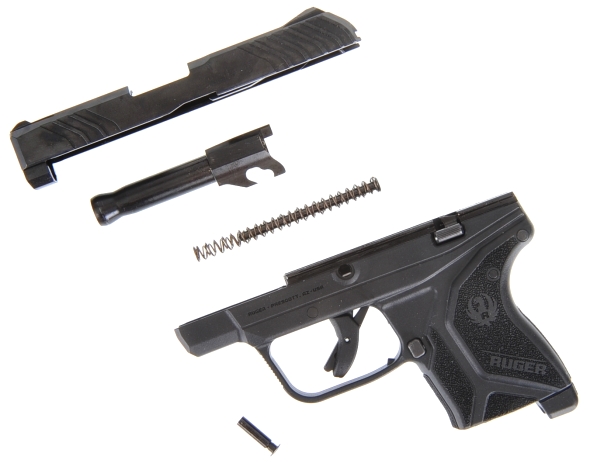
The slide is bushingless. The fit between barrel and slide in controlled by the diameters at the muzzle end of the barrel and the hole in the slide. The barrel is ramped, the bottom side camming surface controls barrel lock/unlock motion. The LCP II is a linkless, tilting barrel, recoil operated, locked breech design. The recoil springs are dual and not captive on the pistol’s guide rod.
|
Ruger LCP II |
|
| Company | Sturm, Ruger & Co., Inc. |
| Point of Manufacturer | Prescott, AZ |
| Model # | 3750 |
| Type of Action | Single Action |
| Caliber | 380 Auto |
| Capacity | 6+1 |
| Barrel Length | 2.75″ |
| Barrel Material | Alloy Steel |
| Rifling Twist Rate | 1:16″ 6 RH |
| Slide Material | Alloy Steel |
| Slide Finish | Blued |
| Grip Frame Material | Glass Filled Nylon |
| Internal Chassis | Precision Machined Aluminum |
| Front Sight | Integral Ramped |
| Rear Sight | Integral Fixed |
| Weight of Firearm | 10.6 |
| Trigger Pull | 6 Lbs 2 Oz |
| Overall Length | 5.17″ |
| Overall Height | 3.71″ |
| Width | 0.91″ |
| Thumb Safety | No |
| Trigger Safety | Yes |
| Magazine Disconnect | No |
| Key Lock | No |
| CA Approved | No |
| MA Approved | No |
| MSRP | $339 |

Just like the LCP, the LCP II has a reliable, beefy extractor. With the breech closed, the extractor groove and rim of a loaded cartridge are visible.
It’s all in the ammo… man
When you hear someone say the 380 Auto isn’t lethal, just stop listening because the suggestion is ludicrous. Will it penetrate like a 357 Magnum or expand to mini softball size like a 45 Auto? Of course not, but that has little to do with the rounds lethality. Outside of movies where “action heroes” need to shoot through a car lengthwise, certain defense of the nearest seven to ten yards and penetration of 12″ or so will do the trick.
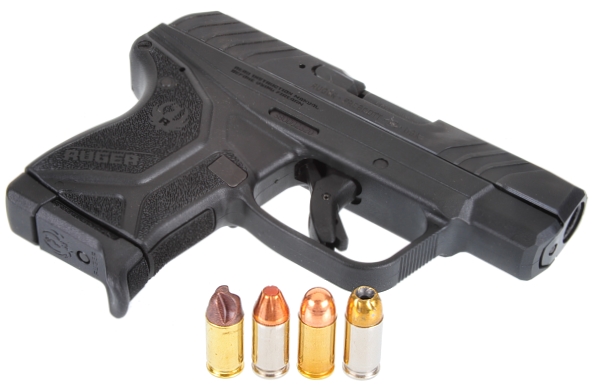
| Caliber |
Ammunition |
Bullet Weight Grains |
Rated MV FPS |
Recorded MV FPS 2.75″ Bbl |
| 380 Auto | Ruger ARX Self Defense | 56 | 1315 | 1268 |
| 380 Auto | Hornady Critical Defense FTX | 90 | 1000 | 991 |
| 380 Auto | PMC Bronze FMJ | 90 | 961 | 869 |
| 380 Auto | Remington Golden Saber JHP | 102 | 940 | 812 |
| Caliber |
Ammunition |
Start Bullet Wt Grains |
End Bullet Wt Grains |
End Bullet Diameter “ |
Penetration Inches |
| 380 Auto | Ruger ARX Self Defense | 56.0 | 56.0 | 0.355 | 14.5 |
| 380 Auto | Hornady Critical Defense FTX | 90.0 | 89.8 | 0.514 | 11.5 |
| 380 Auto | PMC Bronze FMJ | 90.0 | 89.6 | 0.355 | 20.5 |
| 380 Auto | Remington Golden Saber JHP | 102.0 | 99.3 | 0.577 | 13.0 |

The data will always vary from test to test; temperature, chronograph accuracy, ballistic gel batch density can all stack up to shift the numbers a bit, but these are good approximations. The Ruger ARX ammo with hydraulic effect makes the little 380 Auto significantly more effective, regardless the brand of pistol. Where expanding bullet performance tends to fall off as barrel length lesson, the vanes of the ARX projectile seem to always generate a lot of lateral force.
The water jugs in the video were shot in the same sequence as the ammunition appearing on the preceding tables. With velocity and ballistic gel penetration already stated, the intention of the video is to illustrate the ARX bullet’s lateral loading in a fluid medium. A small hole going in and full penetration that split the jug from top to bottom and explosively blew out the back of the jug, something none of the other ammo was able to duplicate. It is an impressive load for the 380 Auto and certainly a good one for the new Ruger LCP II and obviously a bad day for Poland Springs water.
The Ruger LCP II is not approved for +P ammunition, primarily because there is no SAAMI or CIP +P pressure standard for the 380 Auto, only the current maximum average pressure of 21,500 PSI. Yes, there are companies like Buffalo Bore and Grizzly that label their product +P, but that is the company determining that pressure level and in the absence of industry oversight. Consequently, there is no standard for firearm manufacturers like Ruger to test and/or approve use.
Conclusions… Hell, why not?
 I realize that some folks grouse about the 380 Auto and try to pigeon hole it as a firearm and cartridge of last resort… which often leads to un-pheasant debates with groups crowing about its disadvantages or advantages, while others just duck the issue. Sorry, my wife just told me we are having chicken for dinner and I got a bit distracted. The thing I do know about this LCP II and 380 Auto combination is that it is highly concealable and easy to use so, unlike many other concealed carry firearms, this one will not be often be left at home.
I realize that some folks grouse about the 380 Auto and try to pigeon hole it as a firearm and cartridge of last resort… which often leads to un-pheasant debates with groups crowing about its disadvantages or advantages, while others just duck the issue. Sorry, my wife just told me we are having chicken for dinner and I got a bit distracted. The thing I do know about this LCP II and 380 Auto combination is that it is highly concealable and easy to use so, unlike many other concealed carry firearms, this one will not be often be left at home.
The LCP II is easier to shoot than the original LCP which, for some reason, seemed to sting my fingers a bit with prolonged use. First shots are accurate, as are the rest that can quickly follow. I did not put the pistol in a ransom rest, nor did I shoot it from a rest. I did shoot standing with a comfortable hold and I was able to empty magazines filled with any of the ammo noted into fist size groups at 25 feet…and not in the context of Sonny Liston size fists. That type of performance out of a small pistol provides confidence when confidence is most needed.
My wife could shoot the Ruger LCP II accurately and had no problem changing magazines or racking the small slide. She is very picky about what she likes and does not like and the little pistol put a smile on her face. That is important to me as I always make sure whatever firearm I chose for primary or secondary carry, or to keep around the house as defensive hardware, my wife can handle the firearm as well. In this case, that proved to be the case.
My opinion is that Ruger made a very practical set of design revisions to an already successful product. The refinements improved accuracy, function, reliability, and durability while keeping the price tag under control. Nice pistol.
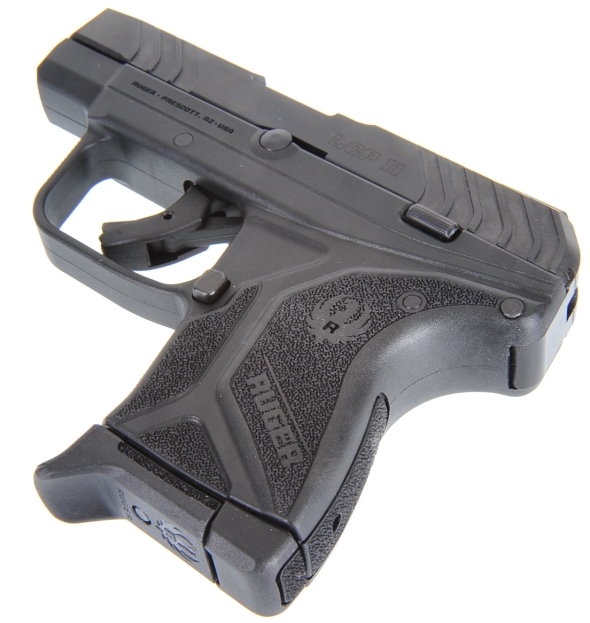

Email Notification